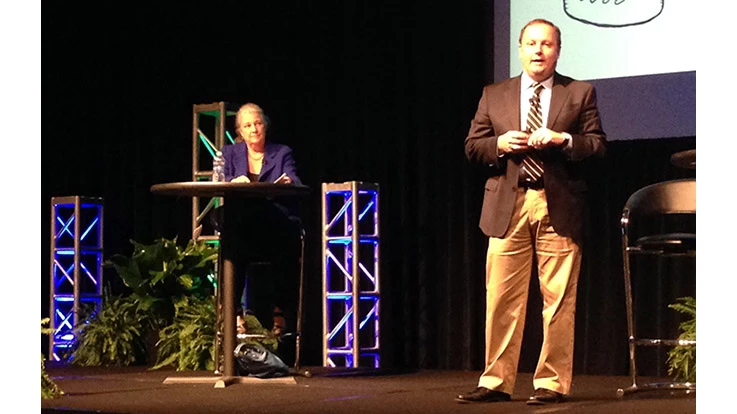
Pictured above, Nina Goodrich of the Sustainable Packaging Coalition and Joe Pickard of ISRI.
It’s no secret that commodity markets have been on a downward trend for much of 2015 and into 2016. Additionally, a number of detractors have been speaking out against recycling lately, questioning its benefits.
A panel during the session The Economic Upside of Plastics Recycling at the Plastics Recycling 2016 event, hosted by Resource Recycling in New Orleans Feb. 1-3, looked for encouraging signs amid the prevailing environment.
“I’m a firm believer that we are creative enough that we will find our way forward in this tough market,” said Nina Goodrich of the Sustainable Packaging Coalition, a Charlottesville, Virginia-based GreenBlue project, who moderated the session.
She added that material recovery facilities (MRFs) are undoubtedly under increasing pressure as they struggle to get the material they need most. To assist with that struggle, the Sustainable Packaging Coalition has introduced ReStart the Cycle, an effort among MRFs, consumers and brands to introduce the How2Recycle Label on the packaging materials that MRFs most want. “Right now we spend a lot of our time on the least recyclable materials,” Goodrich says. “We want to turn that around.”
In a news release about the launch of ReStart the Cycle, GreenBlue writes, “There is significant opportunity to increase the quantity of high value materials, including PET (polyethylene terephthalate) bottles, HDPE (high-density polyethylene) bottles, metal containers and paperboard boxes. These items provide economic value to material recovery facilities. We hope that ReStart the Cycle will assist in economically strong recycling systems and available recycled content.”
Looking long term, Joe Pickard, chief economist and director of commodities for the Institute of Scrap Recycling Industries (ISRI), Washington, said he sees “extremely positive” trends for the recycling industry.
However, he described 2015 as the worst year the industry has seen in several decades if not in a generation, citing excess global production across a number of commodities, the effect of the strong U.S. dollar on export sales and weaker overseas demand for recycled materials, particularly from China, as factors.
Pickard said exports of plastic scrap to China were down by 20 percent in 2015, with pricing having been volatile.
In response to these market conditions, he said ISRI members are focusing on operational efficiencies, improving material quality and product diversification, adding that they are making targeted investments in technology to meet these objectives.
Tim Buwalda of RSE (Reclay StewardEdge), a Toronto-based international consultancy with experience in sustainability issues related to the end-of-life management of packaging and products, said recycling in the United States has plateaued “but certainly not for plastics.” He noted that, according to U.S. Environmental Protection Agency (EPA) figures, of 32.5 billion pounds of plastic waste generated annually, only 6 billion pounds are recycled. Of this recovered material, more postcommerical plastics are exported than postresidential material. Buwalda added that commercially generated plastics commonly include bags and film, agricultural plastics, plastics from electronics and those used in material handling applications.
He said plastics used in electronics provide an example of how trends are changing in favor of recycling, as original equipment manufacturers (OEMs) of electronics increase their use of recycled plastics in manufacturing new devices. Buwalda added that for plastics recycling to be successful, recycling must be integrated with product manufacturing.
Keefe Harrison, executive director of The Curbside Recycling Partnership, Falls Church, Virginia, said the organization’s mission is to provide “more better recycling.” She said that if recycling is looked at only from a landfill diversion standpoint, “we are missing the point.” The industry also supplies resources for manufacturing, making material quality an important consideration.
While public education is an important component of what The Recycling Partnership does, helping to improve recycling rates and the quality of the diverted material, Harrison said, it “only gets you half way there.” She said overall MRF operations had to be considered as well. She advocated for the adoption of “system thinking,” providing equal access for recycling and trash collection.
Paul Yang of Mother Parkers, Mississauga, Ontario, told attendees about a regional recycling study involving the company’s single-serve coffee capsules illustrating that these capsules can be sorted effectively at a MRF.
Mother Parkers partnered with Tim Horton’s on the study, which focused on whether consumers would take the time to separate capsules for recycling and if the objects, which were painted bright pink to help them standout, would flow successfully through a MRF.
Yang said consumers did take the time to separate the grounds from the capsules, 75 percent of which were recovered at the MRF.
Plastics Recycling 2016 was at the Hyatt Regency in New Orleans. The show returns to the same venue in 2017 from March 6-8.
Get curated news on YOUR industry.
Enter your email to receive our newsletters.
Latest from Recycling Today
- Unifi launches Repreve with Ciclo technology
- Fenix Parts acquires Assured Auto Parts
- PTR appoints new VP of independent hauler sales
- Updated: Grede to close Alabama foundry
- Leadpoint VP of recycling retires
- Study looks at potential impact of chemical recycling on global plastic pollution
- Foreign Pollution Fee Act addresses unfair trade practices of nonmarket economies
- GFL opens new MRF in Edmonton, Alberta





